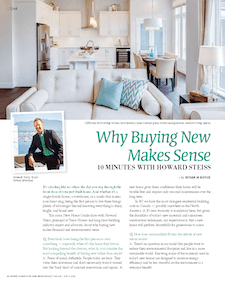Why Buying New Makes Sense

10 minutes with Howard Steiss
by Susan M Boyce
It’s a feeling like no other: the day you step through the front door of your just-built home. And whether it’s a single-family house, a townhouse, or a condo that makes your heart sing, being the first person to live there brings plenty of advantages beyond knowing everything is shiny, bright, and brand new.
This issue, New Home Guide chats with Howard Steiss, principal at Texor Homes and long time building industry expert and advocate, about why buying new makes financial and environmental sense.
Q: Everybody loves being the first person to own something — especially when it’s the home they live in. But looking beyond the obvious, what do you consider the most compelling benefit of buying new rather than resale?
A: Peace of mind, definitely. People today are busy. They value their downtime and don’t necessarily want it turned into the ‘hard time’ of constant renovations and repairs. A new home gives them confidence their home will be trouble free and require only seasonal maintenance over the long term.

Cliffstone by Foxridge Homes incorporates open concept great rooms and generous outdoor living spaces.
In BC we have the most stringent residential building code in Canada — possibly anywhere in the North America. A 10-year warranty is mandatory here, but given the durability of today’s new materials and rainscreen construction techniques, my expectation is that a new home will perform beautifully for generations to come.
Q: How does sustainability fit into the debate of new versus resale?
A: There’s no question in my mind that people want to reduce their environmental footprint and live in a more sustainable world. Knowing many of the materials used in today’s new homes are designed to increase energy efficiency and be less stressful on the environment is a welcome benefit.

Located near Deep Cove, North Vancouver, Parkgate by Texor Homes introduces the space-efficient living kitchen design for the ultimate in flexible living.
For example, windows today have higher insulation values and UV reflective capacity than they did even a decade ago — meaning homes stay warmer in the winter and cooler in the summer. Cement fiber siding panels like HardiPlank are not only a greener alternative to using wood, they’ll withstand years of the toughest weather. Use of low VOC materials mean better indoor air quality — something every homeowner should be entitled to but often don’t get in an older building.
And while at first glance it might not seem like much, contemporary restricted flow faucets, showerheads, appliances and toilets have a huge impact on water conservation. Energy we can get from multiple sources — hydroelectric, solar, wind, natural gas, uranium even the tides. But there is no substitute for water — period. It is a precious commodity we need to conserve.
Q: You’ve always been a strong advocate for the BuiltGreen program, and even before its value was widely recognized, your homes were designed according to those principles. What are some of BuiltGreen’s ‘behind the scenes’ features that benefit people who purchase a brand new home?
A: Sourcing products locally is one intangible that’s not apparent when you look at a home. When you think about it though, buying locally not only provides employment, it reduces the pollution, road congestion, and use of fossil fuel associated with trucking materials over long distances.
The other thing many buyers aren’t aware of is the fact a BuiltGreen home provides a performance rating similar to what you’d get when you comparison shop for a car or appliances. This rating guarantees your new home is built to a specified level of energy efficiency. Not only do you get the benefits of greater energy efficiency while you live in your home, you’ll have an advantage over a non-certified home if you do decide to sell.
Q: As we move to higher density living, homes are becoming more compact. How does the new home marketplace ensure this size change is comfortable?
A: Functional efficiency means prioritizing space in the rooms that are most important for everyday living — for most people that’s the kitchen, living room, bedrooms, and bathrooms. Consumers are moving away from having spaces like a formal dining room — rooms they might only use two or three times a year for events like Thanksgiving or Christmas dinners — and demanding more casual, connected design.

A private, rooftop deck is one way The Woods in South Surrey integrates outdoor living spaces into townhome design.
Designers are responding with floorplans that focus on the ability to utilize every square inch of space. For example, at our Parkgate development in North Vancouver, the entire ground floor is a single, open and extremely flexible “living kitchen” with a movable centre island so you can expand the space when you’re entertaining large groups of family and friends. There’s also a two-piece powder room meaning you and your guests aren’t constantly running up and down the stairs.
Then, rather than cramming all three bedrooms, two bathrooms, and the laundry onto a single level above, we’ve spread them over two floors with the master bedroom occupying the entire top floor. This design means we’re able to achieve a private retreat for parents plus two, spacious children’s bedrooms that are large enough to include room for student study areas or use as a media room or home office.
Q: How does this impact affordability?
A: It’s no secret housing is expensive in Metro Vancouver. It’s straight math that the larger the home, the more it will cost. By designing homes with a smaller footprint, we can make homeownership a reality for more people. So if a 1,200-square-foot, modern townhome lives smarter, saves energy, and lasts longer than an older, 2,000-square-foot resale home in need of renovation, it’s a pretty compelling reason to buy new.
Original Source: METRO VANCOUVER NEW HOME GUIDE | MAR 20 – APR 3, 2015
Original article: The Province
Read original aricle here.
